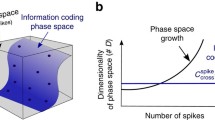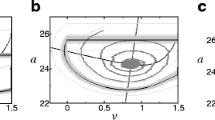Abstract
Cross-correlations between stimuli and neuronal discharges yield information about synaptic events at the investigated neuron. In this paper it is shown that the time course estimated by a cross-correlogram, the cross-correlation function (ccf), represents the input current that upon injection into the perfect integrator model evokes spike sequences that are (almost) identical to those used for estimation of the ccf. Thus, the shape of a ccf may be regarded as an estimate of the underlying postsynaptic current, if the neuron investigated behaves, at least to a first approximation, like a perfect integrator model.
Similar content being viewed by others
References
Abeles M (1982) Quantification, smoothing, and confidence limits for single units' histograms. J Neurosci Methods 5:317–325
Ashby P, Zilm D (1982) Relationship between EPSP shape and cross-correlation profile explored by computer simulation for studies on human mononeurons. Exp Brain Res 47:33–40
Awiszus F (1988a) Continuous functions determined by spike trains of a neuron subject to stimulation. Biol Cybern 58:321–327
Awiszus F (1988b) The adaptation ability of neuronal models subject to a current step stimulus. Biol Cybern 59:295–302
Awiszus F (1989) On the description of neuronal output properties using spike train data. Biol Cybern 60:323–333
Awiszus F (1990) On a method to infer quantitative information about the current driving action potential generation from neuronal spike train data. Biol Cybern 62:249–257
Awiszus F, Feistner H, Schäfer SS (1991) On a method to detect long-latency excitations and inhibitions of single hand muscle montoneurons in man. Exp Brain Res 86:440–446
Awiszus F, Schäfer SS (1989) Re-afferent effects of individual static and dynamic γ-stimuli during maintained fusimotor stimulation. Brain Res 489:41–48
Cope TC, Fetz EE, Matsumura M (1987) Cross-correlation assessment of synaptic strength of single Ia fibre-connections with triceps surae motoneurones in cats. J Physiol (London) 390:161–188
Fetz EE, Gustafsson B (1983) Relation between shapes of postsynaptic potentials and changes in firing probability of cat mononeurones. J Physiol (London) 341:387–410
Gerstein GL, Kiang NY-S (1960) An approach to the quantitative analysis of electrophysiological data from single neurons. Biophys J 1:15–28
Gustafsson B, McCrea D (1984) Influence of stretch-evoked synaptic potentials on firing probability of cat spinal motoneurones. J Physiol (London) 347:431–451
Holden AV (1976) Models of stochastic activity of neurones. Springer, Berlin Heidelberg New York
Kirkwood PA (1979) On the use and interpretation of cross-correlation measurements in the mammalian central nervous system. J Neurosci Methods 1:107–132
Kirkwood PA, Sears TA (1978) The synaptic connexions to intercostal motoneurones as revealed by the average common excitatory potential. J Physiol (London) 275:103–134
Knox CK (1974) Cross-correlation functions for a neuronal model. Biophys J 14:567–582
Knox CK, Poppele RE (1977) Correlation analysis of stimulusevoked changes in excitability of spontaneously firing neurons. J Neurophysiol 40:616–625
Lapique L (1907) Recherches quantitatives sur l'excitation electrique des nerfs traitee comme une polarization. J Physiol (Paris) 9:622–635
Midroni G, Ashby P (1989) How synaptic noise may affect cross-correlations. J Neurosci Methods 27:1–12
Miles TS, Türker KS, Le TH (1989) la reflexes and EPSPs in human soleus motor neurons, Exp Brain Res 77:628–636
Moore GP, Perkel DH, Segundo JP (1966) Statistical analysis and functional interpretation of neuronal spike data. Annu Rev Physiol 28:493–522
Moore GP, Segundo JP, Perkel DH, Levitan H (1970) Statistical signs of synaptic interaction in neurons. Biophys J 10:876–900
Perkel DH, Gerstein GL, Moore GP (1967) Neuronal spike trains and stochastic point processes. I. The single spike train. Biophys J 7:391–418
Polyakov AV (1991) Synaptic noise and the cross-correlation between otoneuron discharges and stimuli. NeuroReport 2:489–492
Scharstein H (1979) Input-output relationship of the leaky-integrator neuron model. J Math Biol 8:403–420
Surmeier DJ, Weinberg RJ (1985) The relationship between cross-correlation measures and underlying synaptic events. Brain Res 331:180–184
Author information
Authors and Affiliations
Rights and permissions
About this article
Cite this article
Awiszus, F. The relationship between a neuronal cross-correlogram and the underlying postsynaptic current. Biol. Cybern. 67, 279–283 (1992). https://doi.org/10.1007/BF00204401
Received:
Accepted:
Issue Date:
DOI: https://doi.org/10.1007/BF00204401




